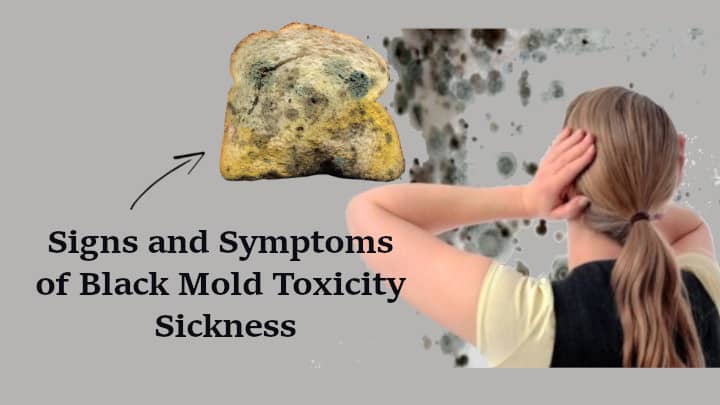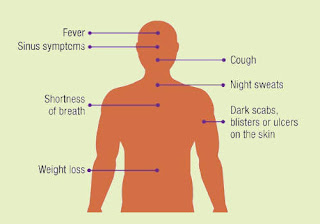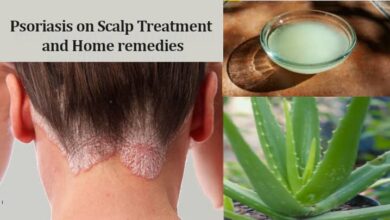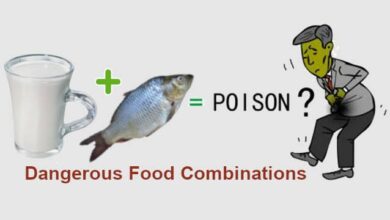11 Signs and Symptoms of Black Mold Toxicity Sickness in Humans

Did you know what are the signs and symptoms of black mold toxicity sickness? Mold can be developed anywhere and can irritate you like hell as it never looks good and can affect your health. According to various studies, more than 1000 types of molds can develop in particular areas like sink area, shower area, roof especially with leakage, etc.
Black mold or mold toxicity can’t be comprehended properly by the people, and mostly they ignore it until they face severe health conditions. Humid and wet environments are much responsible for mold exposure.
In this Article
- What is Black Mold
- Signs and Symptoms of Black Mold Toxicity Sickness
- Who is at Risk for Mold Toxicity
- What happens if you accidentally eat moldy bread
- Can black mold make you nauseous
- How to Prevent Black Mold
What is Black Mold
Molds have different types, and black molds are quite dangerous as they appear black and dark greenish. The upper layer looks wet and jelly type form, and basically, molds are considered a fungus that spreads rapidly and is not safe for humans.
When molds get much moisture, they release more mycotoxin that causes health problems. Mostly you will see molds growth in the kitchen area around the sink, shower area, in the pipes, in the attic and the roof area, in the basement, or sometimes in the lobby area or bedrooms.
Some common house molds are Alternaria, Penicillium, aspergillums, Cladosporium, Stachybotrys, etc. these tiny spores are toxic and visited by air and can’t see by naked eyes. They can also affect the food items, and eating such food can give you severe infections and allergies.
Signs and Symptoms of Black Mold Toxicity Sickness

Here we are mentioning everything that you need to know about mold toxicity, risk factors, prevention, and signs so let’s have a closer look at that:-
1. Breathing Difficulty
People who inhale or contact mold toxicity may feel breathing difficulty or shortness of breathing. Black molds release toxins with their tin spores that enter the body when you breathe, and they can influence the whole respiratory system.
If you feel anything wrong with your breathing and live in such a house with molds, you must ask for expert advice.
2. Sneezing and Running Nose
Sneezing can be normal, but constant sneezing isn’t. If you are a healthy person and never faced any allergies, you are having constant sneezing; then you must check your home.
The immune system tries to protect the body from an allergic reaction that causes sneezing and running nose to develop mucus so that toxic spores can be prevented from entering the body through a nasal area. That’s why you feel running nose or nasal congestion.
3. Headache
Headache is also a common sign of mold toxicity, and headaches can cause other reasons. When mycotoxin released by black molds affects or enters the body, it becomes a primary cause of a headache.
The toxic chemical affects the brain’s neurotransmitters and appears sinus issues, and one may feel constant headaches.
4. Coughing and Wheezing
The constant exposure to black molds and harmful chemicals attacks the lungs and respiratory system and irritates the throat area, causing rough coughing.
You may feel wheezing due to mold exposure adding discomfort in the chest area and irritated lungs.
5. Sore Throat
Mold toxins provoke soreness in the throat area. One may feel irritation and pain in the throat due to exposure to toxins in the mucus membrane.
If the problem can’t be diagnosed properly, it can be a serious problem.
6. Muscle Pain
If you feel unexplained muscle pain without doing any heavy physical activity, you must check your living area properly; black molds can be responsible for muscle pain.
People with mold spores exposure feel muscle pain and discomfort in the body.
7. Nausea and Vomiting
Higher exposure to mycotoxins and chemicals in the body can lead you nausea and vomiting because the whole immune system gets attacked by toxins and tries to eliminate them results vomiting and nausea.
8. Itchy Skin
Excessive mold exposure can appear in itchy skin and skin rashes, and your largest organ may get irritated the most. You may have itchy and dry skin with a rapid spread of patches and rashes.
You may feel hives and scaly skin that don’t go quickly even after using creams and lotions to treat the skin allergy.
9. Itchiness in the Throat, Nose, and Eyes
If you notice constant itchiness in the eyes, throat, and nasal area without any other prior reason, it is due to mold toxicity and is known as one of the important signs of mold exposure.
10. Depression
People who stay at their homes mostly and have regular contact with mold toxicity also feel depressed and sad. Mold spores not only affect you physically but also affect your mental health too.
The studies also announced that black molds could affect mental health, and stress and sadness can be severe conditions.
11. Digestive issues
People with mold exposure stated that they have very poor digestion after remaining in contact with mycotoxins. You may also feel bloating, poor appetite, stomach pain, diarrhea, nausea, sudden weight loss, and vomiting.
Who is at Risk for Mold Toxicity?
Though anyone can still be affected by mold toxicity, people with asthma or suffering from any allergies are more prone to mold toxicity.
People with respiratory illness or a weak immune system are at risk for mold toxicity, and the symptoms mustn’t be ignored.
Indoor molds are more dangerous for the people who mostly stays at their home.
What happens if you accidentally eat moldy bread?
Moldy bread may also contain toxins that are dangerous to one’s health. Food poisoning can result from eating moldy bread. One of the most common side effects of eating moldy bread is a stomach ache, but other issues can also arise like breathing problems, sore throat ,nausea and vomiting.
Can black mold make you nauseous?
Yes, black mold can make you nauseous. Black mold is a type of fungus that can produce a potent form of mycotoxins that can cause adverse health effects, including nausea and vomiting. If you experience these symptoms after exposure to black mold, you should seek medical attention.
How to Prevent Black Mold
When you come to know about the risk of mold toxicity, you seriously want to prevent it or get rid of the situation, and here we are listing some of the ideas that will help you:-
- Maintain proper hygiene and clean the more susceptible area, like bathrooms, kitchen, sink area, washbasins, etc.
- Wear a mask or cover your mouth and nose with a cloth while cleaning the areas covered with molds so they can’t enter the body.
- Wash your hands and clothes well and use an anti-fungal detergent or liquid to wash and disinfect the clothes.
- Keep checking the leakage and excess moisture in the house or office area where you spend enough time.
- On the fans, the air can help terminate the spread of molds.
- Keep our curtains and carpets dry, and don’t let your food open.
- Get expert help to clean such areas so you can stay healthy.
References
- “Mold and Human Health: a Reality Check” – PubMed
- “Indoor Mold, Toxigenic Fungi, and Stachybotrys chartarum”– Ncbi
- “A Spreading Concern: Inhalational Health Effects of Mold” – NCBI
- “Effects of toxic exposure to molds and mycotoxins”– PubMed
- “Black Mold Exposure: What It Is and Isn’t” – Healthline





